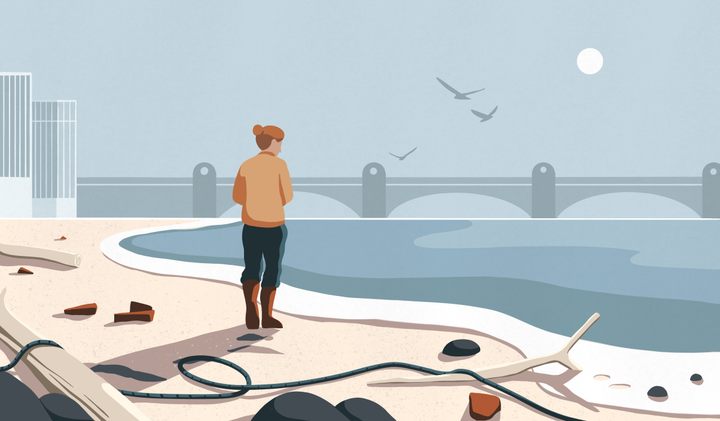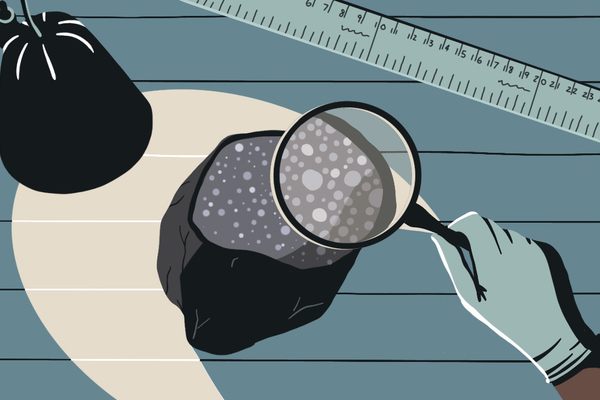
How to Scavenge for Bits of History Like London’s Mudlarks
A guide to scouting for humble treasures on the shore of the Thames.
There’s a lot to see and no time to waste, because the water is coming. Lara Maiklem is getting out ahead of me, sure-footed on the slick foreshore of the River Thames, the part that is exposed when the tide goes out. I keep slowing us down because I’m distracted by all the stuff in the muck—the smashed clay pipes, the centuries-old animal bones, and brick roof tiles, some of which may have been scorched centuries ago in the Great Fire of London. I want to look at everything, but the water won’t wait for indiscriminate curiosity. It’s grayish brown, and it’s about to make a move on our shoes.
“Are they fairly waterproof, those?” Maiklem asks, nodding to my boots. I shrug. They’re fine in slush, but I don’t know how they’ll handle a rising river. We’re heading toward the Millennium Bridge in central London, in front of the Tate Modern, and we’ve got to get there before the tide blocks our way. On the walls overlooking the river, green smudges high above my head shows just how high the water will reach. At some points along its course, the Thames can fluctuate by as much as 20 feet between high and low tide. We can’t dawdle.
“Anything brown or green is slippery,” Maiklem calls out. For a while, we work in silence. Shells and flint and rocks clink underfoot. Maiklem crouches, barely breaking stride, and quickly decides what to grab and stow in her “bum bag,” or fanny pack. Though the river is cleaner now than it has been in a long time, it’s still flecked with waste from the city’s overloaded sewer system, so she pulls on a pair of blue plastic gloves.
Maiklem is one of the city’s most famous contemporary mudlarks, people who passionately canvass the shore in pursuit of bits of history that emerge from the sediment. (Her book, Mudlark: In Search of London’s Past Along the River Thames, came out in late 2019.) She’s part of a tradition that spans centuries. Today’s searchers are hobbyists, in pursuit of old pilgrimage badges, bits of Saxon pottery, ancient coins, or animal bones big enough to loop around your finger like a ring. But back in centuries past, mudlarking was a profession, of sorts, for some of the city’s destitute, who wandered around the festering, open sewer of the Thames in search of bits of coal, rags, copper nails, and anything else they could sell to survive.

Nineteenth-century journalist Henry Mayhew discussed mudlarks (along with rat-catchers, sewer flushers, and other other people whose plights were overlooked by most reporters) in his multivolume London Labour and the London Poor, first published in 1851. He reported that “mudlarks” had earned that moniker because they were often compelled, “in order to obtain the articles they seek, to wade sometimes up to their middle through the mud left on the shore by the retiring tide.” The river left its mark on them, Mayhew continued: “Their bodies are grimed with the foul soil of the river, and their torn garments stiffened up like boards with dirt of every possible description.”
Today’s mudlarks are better outfitted, and they’re out there by choice rather than as a matter of survival. They occasionally come across finds that date all the way back to Londinium, the era of Roman settlement, and some very old, spectacularly remarkable finds, such as Bronze Age swords and a bent dagger, were recently on view at the Secret Rivers exhibition at the Museum of London Docklands. But the majority of the things salvaged from the mud are more recent—often medieval or later—and are small, humble reminders of what people used, maybe loved, and eventually discarded. Exploring the shore as a mudlark is like conducting a swift, simple, satisfying archaeological dig, with almost no digging at all.
Maiklem brought me to this part of the Thames, not far from the ancient, heavily protected site of the Roman-era Queenhithe dock, because it is a particularly rich picking ground. The finds that surface here often reflect the city’s industrial past. Household trash, too, wound up here because it was lost or dumped or shoveled in. “Everything we’re standing on, pretty much, is here because human beings have put it here,” Maiklem says. The river is eating these deposits away, and as they erode, items begin to resurface. Older objects are jumbled together with newer ones—artifacts from Roman England might sit alongside ones from the Middle Ages and more from the Victorian era. “It’s a total mishmash of history here,” Maiklem says, “which is why it’s okay for people to come pick stuff up.” (Read on for rules about what mudlarks can keep, and what they must report to authorities.) At an archaeological site, stratigraphy and context are critical: Each layer and the things around it tell a story. Here, in such a dynamic environment, context is unlikely to carry much meaning, if it exists at all. “What we’re seeing is here on one tide, and gone on the next,” Maiklem says.
Maiklem is out on the shore of the Thames as often as she can be, and she leaves with loads of fascinating finds that she organizes into a tackle box. On this day, a prize find is the narrow, well-preserved sole of a shoe, with clipped angles that suggest pinching and maybe blisters—as well as the sight of a person clomping around gas-lit London hundreds of years ago.
If you’re just beginning, here’s what you need to know to mudlark like a pro.
Time it right
Mudlarks on the Thames are always racing the tide. Consult a tide chart, and leave yourself enough time to explore. The water comes in quick, so plot your exit by confirming where and how you’ll leave the shore using the stairs and ladders that lead back up to street level. Be sure you can get to them before the water does.
Read the shore
Look for dips, inlets, and walls where objects might get trapped and start to pile up. If you spot a pile of black, charcoal-like material, that’s a clue that there might be a rich stockpile beneath it. Old wooden or metal posts, and the dips and hollows that surround them, are a good place to hunt, too, since small items such as coins can get stuck there. A smattering of nails is also a sign that there could be more around. “Metal attracts metal, and the river washes everything of similar size and weight together,” Maiklem says.
Learn the patterns
You’ve got to train your eye. “You’re looking for perfect circles and straight lines that nature doesn’t do,” Maiklem says. Pottery is easy to spot because of its color and curves. To decode your sherds, look for distinctive glazes or patterns, which, with a little research, might point to specific eras. Pins and clay pipes are often quite discernible, too. Pipes were cheap and ditched in huge quantities—so you might find dozens of smashed stems or bowls in just a few minutes. Also look out for squared shapes that were once the tiles of London’s roofs. Ones with round holes were affixed before the Great Fire, Maiklem writes, and the ones with square, triangular, or diamond-shaped holes were added after.

Follow the law
All mudlarks need permits from the Port of London Authority, and the majority of those permits are what Maiklem describes as “eyes-only,” meaning that they entitle the holder to scan the shore with their eyeballs, and prohibit disturbing more than just a couple of inches of sediment in search of finds.
This rule is in place because digging into the foreshore can be dicey. Poking at packed-down garbage can make the shore porous and unsteady. Allowing more water to seep in can hasten erosion, which “is dreadful at the moment,” Maiklem says. Erosion is generally good for mudlarks, but it’s bad for the structural integrity of the city’s riverside. “There’s plenty lying on the surface, and I think we should be focused on picking up what’s about to wash away,” Maiklem says.
Mudlarks are also required to report anything of archaeological value—including anything that qualifies as “treasure,” such as objects that contain at least 10 percent precious metal by weight and are a minimum of 300 years old—to the Portable Antiquities Scheme officer at the Museum of London. Any human remains must be reported, too.
Mudlarks have a few unwritten rules, also. Mainly, don’t mudlark right next to someone else. There’s plenty of space on the shore, and no one wants to argue over who found what.
Don’t take everything
The shore is full of intriguing bits and bobs, and there’s a certain urgency, knowing that the water will be back soon, and that anything you don’t pick up is likely to be washed away. There were times I panicked a little and wanted grab everything I saw. Maiklem reminded me that it’s not possible to scoop up everything you see, and you wouldn’t want to anyway. In a way, I felt responsible for the bits of pottery I had found, as the first person to touch them in hundreds of years.
Maiklem says that mudlarking involves a certain amount of making peace with loss. When something drops back into the water, she says, she reminds herself, “It was only mine for a little while, and it wasn’t really mine.” She also passes on a lot of stuff, especially if she knows she has better examples at home. “I only take what I don’t already have,” she says. “I don’t bring everything back—otherwise, I’d come back with bagfuls.” In her book, Maiklem writes about changing her mind about some of her haul, and how she scattered a slew of 18th-century clay pipes back where she had found them.
Each tide is a chance to “shake hands with history,” Maiklem says. Mudlarking is an opportunity to touch the past, but just a sliver of it—accepting that no one is ever able to know it all.











Follow us on Twitter to get the latest on the world's hidden wonders.
Like us on Facebook to get the latest on the world's hidden wonders.
Follow us on Twitter Like us on Facebook